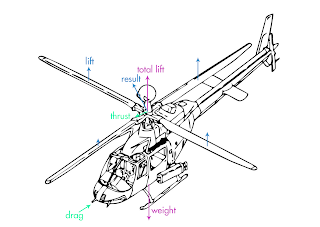Helicopters
INTRODUCTION
The main difference between the Helicopter and an Airplane is the main source of lift. Helicopter derives its lift from a rotating aerofoil called rotor. The rotating wing. Main rotor of a Helicopter has two or more blades depending on the design and size of the Helicopter. Each blade is an aerofoil in design.
FORCES ACTING ON A HELICOPTER IN FLIGHT
There are four forces acting on the Helicopter. Lift is the force required to support the weight of the Helicopter.
TAIL ROTOR OR ANTI-TORQUE ROTOR
According to Newton third law of Motion the torque force applied to the rotor shaft of a helicopter to turn the rotor causes an equal and opposite force which would turn the fuselage of the helicopter in the opposite direction unless measures were taken to prevent it. Tail rotor prevents the helicopter fuselage from turning.
HELICOPTER CONTROLS
COLLECTIVE PITCH CONTROL
Increases or decreases the pitch of all main rotor blades simultaneously. This control is located at the pilots left. To raise the helicopter from the ground, collective pitch is increased, thereby increasing lift to all blades evenly.

CYCLIC - PITCH CONTROL
Purpose of the cyclic pitch control is to cause tip path plane of the main rotor to tilt, as required to provide for movement of the helicopter in a desired direction.
AUTO-ROTATION
Curve’s contribution to rotating wing machine, paved the way for practical helicopters. He discovered the principle of “autorotation”. This enabled the design of a safe flying machine, which would not stall and crash when its speed through the air was reduced to ZERO.
The principle of autorotation is that there is a small positive angle of pitch at which the blades could be set to ensure that the rotor would continue to rotate automatically in the airstreams, without an engine to drive it, and still develop enough lift for sustained in flight.
HELICOPTER CONFIGURATIONS
SINGLE ROTOR ARRANGEMENT
In this arrangement single rotor and a tail rotor is used. Single rotor helicopter is light in weight, But single rotor machines have limited lifting and speed capabilities and severe safety hazard during ground operations due to the position of the Tail rotor.
TANDEM ROTOR HELICOPTER
This helicopter uses two synchronized rotors turning in opposite directions. This design eliminates the need for an anti-torque rotor, since one rotor cancel the torque of other. Each rotor has three blades. This helicopter is capable of lifting large loads.
SIDE BY SIDE ROTOR HELICOPTER
Side by side helicopter has two main rotors, positioned out from sides of the fuselage. Rotors turning in opposite direction which eliminate the need for a tail rotor. It has excellent stability and efficient in forward flight.
In coaxial rotor helicopter, fuselage torque is eliminated by using too counter rotating rigid main rotors, mounted one above the other on a common shaft. This has the forward speed more then 250 KN. [129 m/s] Lift load at high forward speed is carried by the advancing blades.





















No comments:
Post a Comment